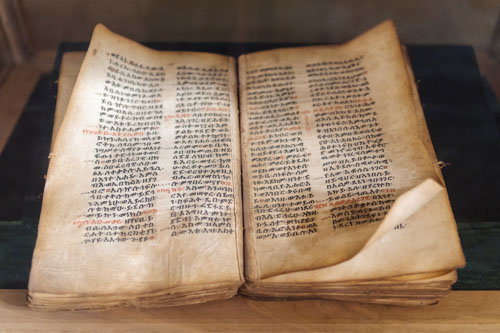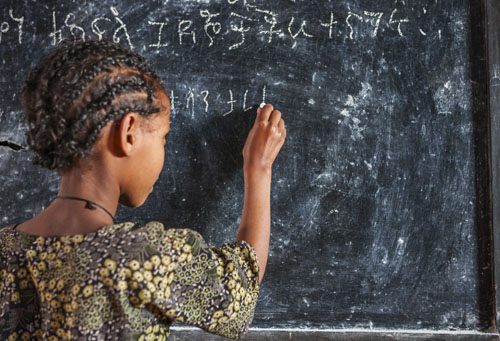Writing in Amharic
Written by Rebecca Schmor
About the Amharic Language
Amharic is among the oldest languages in the world and one of the five official languages of Ethiopia. It was the sole official national language until 2020, when Afar, Oromo, Somali, and Tigrinya were given official status. Amharic is currently spoken and learned by close to sixty million people in Ethiopia, with a few million more speakers in neighbouring Eritrea and the diasporas of North America, Australia, and Europe. Amharic is also the liturgical language of the Ethiopian Orthodox church and used by the Rastafari religion around the world.

Amharic belongs to the Afroasiatic language family and is a Semitic language. Unlike other Semitic languages such as Arabic, Aramaic, or Hebrew, the Amharic language is written from left to right. Its alphabet uses Ge‛ez script and has 33 characters, each of which has seven different forms. Examples of Amharic words include ሰላም (selam) for “Hello” and አመሰግናለው (ameseginalew) to say “Thank you.”
Untranslatable Amharic Words
Like all languages, Amharic is a product of its unique cultural and historical influences. With its long history, the Amharic language has maintained several distinctive features, including the following words that are untranslatable into most other languages.
ትዝታ (Tizita)
This word describes a bittersweet feeling of remembrance or longing for a moment, thing, or person in one’s past. Stronger than nostalgia, this unique Amharic word is perhaps similar to the Portuguese “saudade,” whose meaning is also considered extremely difficult to convey or translate into other languages.
እሰይ (Issey)
Described as an expression of “cheering fate,” this word is used for a sense of extreme satisfaction when something good or bad happens. When used to celebrate the misfortune of others, this word is similar to the German “Schadenfreude”: a feeling of pleasure derived from someone else’s pain.

አይዞሽ (Ayzosh) / አይዞህ (Ayzoh)
This is another Amharic word that is difficult to translate, used to comfort others in emotional or physical pain. “Ayzosh” is the form used when talking to a female, while “Ayzoh” is for a male. Translating to something like “be strong” or “have courage,” the word is used to tell people not to worry or that everything is going to be okay. A close equivalent in another language could be found in the one-word Italian expressions “forza” (literally “strength”) or “coraggio” (meaning “courage”).
እንትን (Intin)
This is an Amharic filler word that also means “the thing.” It is used when someone is collecting their thoughts or can’t find the word they want to say. While most languages fill these pauses with a sound like “umm” or “ehh,” there are other languages that, like Amharic, also use a multisyllabic word as a filler. In Mexico, the Spanish word “este” is used, which means “this.” Mandarin, instead, uses the word for “that,” “那个” (pronounced nèige), to fill pauses in conversation.
Want to know how you can use these “untranslatable” Amharic words in a classroom activity? Continue reading below.
Translating Untranslatable Words
Description
This activity invites learners to identify and explain “untranslatable” words in different languages, while applying and analyzing communication strategies relevant to language learning. The activity is designed for high-intermediate or advanced English language learners but can be adapted to any target language or proficiency level by translating or modifying the activity instructions and resources.
Steps
1. Brainstorming “untranslatable” words (20 minutes)
Ask learners to brainstorm (or look up examples of) words in other languages that cannot be easily translated into the target language. You can also give students resources like the search engine Eunoia or blog posts such as the following:
- 20 amazing words that don’t exist in English — but really should
- 12 Wörter aus aller Welt, die man nicht exakt übersetzen kann (12 words from around the world that can’t be directly translated)
- 20 palabras geniales que no tienen traducción (20 amazing words with no translation)
- Les mots étrangers intraduisibles (Untranslatable words from other languages)
2. Explaining “untranslatable” words (20 minutes)
Ask learners to read the “Discovering Languages: ‘Untranslatable’ Words in Amharic” blog post and to fill in the rest of the chart below, adding a few words from the brainstorming in step 1.
| Language | Untranslatable Word | Meaning in English | Meaning in Other Languages? |
| Amharic | ትዝታ (Tizita) | A bittersweet feeling of remembrance or longing for a moment, thing, or person in one’s past, stronger than nostalgia | “Saudade” in Portuguese |
| Amharic | እሰይ (Issey) | ||
| Amharic | አይዞሽ (Ayzosh) / አይዞህ (Ayzoh) | ||
| Amharic | እንትን (Intin) | ||
3. Analyzing communication strategies (20 minutes)
Take up the chart and, as learners share the meanings of their “untranslatable” words, discuss how they explained these words in the target language. Highlight any instances of the strategies of paraphrasing (e.g., using a close synonym like “nostalgia” for the word “ትዝታ/Tizita”), reconceptualization (e.g., using a chunk of words like “a bittersweet feeling of remembrance or longing” to describe the single word “ትዝታ/Tizita”), or substitution (e.g., replacing the Amharic word “ትዝታ/Tizita” with the Portuguese word “saudade”). Ask learners to reflect on which strategies they already use when communicating in the target language, and which ones they could try to use in the future.
Commentary
This activity requires learners to refer to languages other than the target language, while enhancing their practical knowledge of communication strategies for use in any language. It incorporates knowledge not only of other languages students may already know, but also of those that are unfamiliar. This can encourage students to recognize and value linguistic diversity; to view the unique “untranslatable” words as part of the richness — and not a problem or deficit — of other languages. It can help students to realize that, indeed, anything can be translated, by using different strategies of expression and considering how meanings carry over across cultures. As such, this activity supports linguistically inclusive and plurilingual approaches to language education.
Further Reading
Littlemore, J. (2003). The communicative effectiveness of different types of communication strategy. System, 31(3), 331–347. DOI: 10.1016/S0346-251X(03)00046-0
Van Viegen, S., & Zappa-Hollman, S. (2020). Plurilingual pedagogies at the post-secondary level: Possibilities for intentional engagement with students’ diverse linguistic repertoires. Language, Culture and Curriculum, 33(2), 172–187.




